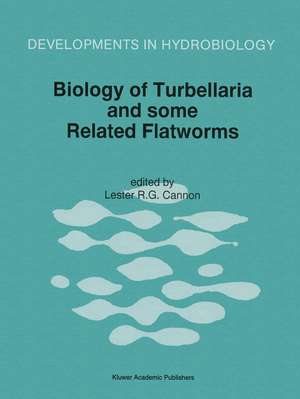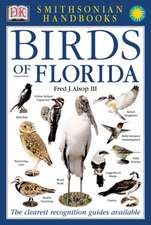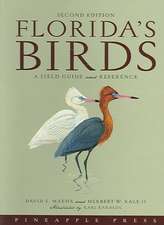Biology of Turbellaria and some Related Flatworms: Proceedings of the Seventh International Symposium on the Biology of the Turbellaria, held at Åbo/Turku, Finland, 17–22 June 1993: Developments in Hydrobiology, cartea 108
Editat de Lester R.G. Cannonen Limba Engleză Paperback – 14 oct 2012
The 60 contributions to Biology of Turbellaria and some Related Flatworms cover taxonomy and phylogeny, biogeography and genetics, ecology and behaviour, Anatomy and ultrastructure, development and regeneration, genes and sequences, and neurophysiology. Biology of Turbellaria and some Related Flatworms is the most recent compilation in the series published in Hydrobiologia since 1981, covering research on these flatworms assembled by the world's leading authorities on the group.
Audience: These papers present the advanced student and serious researcher with up to date information on an important, but often neglected group whose place in the animal kingdom demands greater attention.
Din seria Developments in Hydrobiology
- 18%
 Preț: 1229.10 lei
Preț: 1229.10 lei - 18%
 Preț: 959.98 lei
Preț: 959.98 lei - 18%
 Preț: 963.91 lei
Preț: 963.91 lei - 15%
 Preț: 648.24 lei
Preț: 648.24 lei - 15%
 Preț: 637.89 lei
Preț: 637.89 lei -
 Preț: 378.23 lei
Preț: 378.23 lei - 15%
 Preț: 644.95 lei
Preț: 644.95 lei - 18%
 Preț: 952.09 lei
Preț: 952.09 lei - 20%
 Preț: 558.87 lei
Preț: 558.87 lei - 18%
 Preț: 1833.65 lei
Preț: 1833.65 lei -
 Preț: 393.59 lei
Preț: 393.59 lei -
 Preț: 406.54 lei
Preț: 406.54 lei - 18%
 Preț: 1226.73 lei
Preț: 1226.73 lei - 18%
 Preț: 956.99 lei
Preț: 956.99 lei - 24%
 Preț: 1060.51 lei
Preț: 1060.51 lei - 18%
 Preț: 1229.28 lei
Preț: 1229.28 lei - 20%
 Preț: 569.30 lei
Preț: 569.30 lei -
 Preț: 368.79 lei
Preț: 368.79 lei - 24%
 Preț: 817.46 lei
Preț: 817.46 lei - 18%
 Preț: 958.25 lei
Preț: 958.25 lei - 18%
 Preț: 953.03 lei
Preț: 953.03 lei -
 Preț: 384.75 lei
Preț: 384.75 lei - 24%
 Preț: 1582.91 lei
Preț: 1582.91 lei - 24%
 Preț: 1051.68 lei
Preț: 1051.68 lei - 18%
 Preț: 943.57 lei
Preț: 943.57 lei - 18%
 Preț: 1235.76 lei
Preț: 1235.76 lei - 24%
 Preț: 800.02 lei
Preț: 800.02 lei - 24%
 Preț: 803.55 lei
Preț: 803.55 lei - 18%
 Preț: 948.29 lei
Preț: 948.29 lei
Preț: 388.87 lei
Nou
Puncte Express: 583
Preț estimativ în valută:
74.41€ • 77.90$ • 61.57£
74.41€ • 77.90$ • 61.57£
Carte tipărită la comandă
Livrare economică 01-07 aprilie
Preluare comenzi: 021 569.72.76
Specificații
ISBN-13: 9789401040259
ISBN-10: 9401040257
Pagini: 340
Ilustrații: XVIII, 316 p.
Dimensiuni: 195 x 260 x 18 mm
Ediția:Softcover reprint of the original 1st ed. 1995
Editura: SPRINGER NETHERLANDS
Colecția Springer
Seria Developments in Hydrobiology
Locul publicării:Dordrecht, Netherlands
ISBN-10: 9401040257
Pagini: 340
Ilustrații: XVIII, 316 p.
Dimensiuni: 195 x 260 x 18 mm
Ediția:Softcover reprint of the original 1st ed. 1995
Editura: SPRINGER NETHERLANDS
Colecția Springer
Seria Developments in Hydrobiology
Locul publicării:Dordrecht, Netherlands
Public țintă
ResearchCuprins
Taxonomy and Phylogeny.- Plathelminthes or Platyhelminthes?.- Two peculiar new genera of Typhloplanoida from the Western Indian Ocean.- Phylogenetic relationships within the Archiloa genus complex (Proseriata, Monocelididae).- An elaboration of the evolutionary morphological basis for the systematics of the Plathelminthes.- The basic organization of the Plathelminthes.- Aspects of the phylogeny of Platyhelminthes based on 18S ribosomal DNA and protonephridial ultrastructure.- 5S rRNA sequences of 12 species of flatworms: implications for the phylogeny of the Platyhelminthes.- Biogeography and Genetics.- Brackish-water Plathelminthes from the Faroe Islands.- Platyhelminths as paleogeographical indicators.- Taxonomy and geographical distribution of Dugesia japonica and D. ryukyuensis in the Far East.- Geographical distribution of Phagocata vivida in the Far East.- Chromosomes of Temnocephala minor, an ectosymbiotic turbellarian on Australian crayfish found in Kagoshima Prefecture, with karyological notes on exotic turbellarians found in Japan.- A review of chromosomal variation in Dugesia japonica and D. ryukyuensis in the Far East.- Chromosome bands in freshwater triclads.- Ecology and Behaviour.- Where Turbellaria? Concerning knowledge and ignorance of marine turbellarian ecology.- Stylochus tauricus, a predator of the barnacle Balanus improvisus in the Black Sea.- Predation behaviour of land planarians.- The influence of body size on immediate reproductive success in Dugesia gonocephala (Tricladida, Paludicola).- Reproductive behaviour in Dugesia gonocephala (Tricladida, Paludicola).- Anatomy and Ultrastructure.- The anatomy of Microplana termitophaga from Zimbabwe and Kenya: confirmation of the subfamily and genus.- Comparison of the nervous system of the rhabdocoel Mesostoma ehrenbergii with that of the polyclad Notoplana acticola.- Glyoxylic acid induced fluorescence in the nervous system of Gyratrix hermaphroditus (Kalyptorhynchia, Polycystididae).- The importance of the fixation of colour, pattern and form in tropical Pseudocerotidae (Platyhelminthes, Polycladida).- Structure and maintenance of the epidermis in Friedmaniella sp. (Prolecithophora).- A scanning electron microscope study of Craspedella sp. from the branchial chamber of redclaw crayfish, Cherax quadricarinatus, from Queensland, Australia.- An electron microscope study of primary epidermis formation in freshwater planarian embryos.- Ultrastructure of the epidermis of Meara stichopi (Platyhelminthes, Nemertodermatida) and associated extra-epidermal bacteria.- Ultrastructure and differentiation of ciliated pits in Microstomum lineare (Turbellaria, Macrostomida).- Ultrastructure of the ciliary pits in the Geocentrophora group (Platyhelminthes, Lecithoepitheliata).- A new type of photoreceptor in Anthopharynx sacculipenis (Plathelminthes, Solenopharyngidae).- Ultrastructure of the nerve cells and sensilla of Geocentrophora baltica (Platyhelminthes, Lecithoepitheliata) and the surface sensilla in the Geocentrophora group.- Structure and function of the reticular cell in the planarian Dugesia dorotocephala.- Fine structure of the astrocyte-like neuroglial cell in the planarian Dugesia dorotocephala.- Ultrastructural and cytochemical studies of the female gonad of Prorhynchus sp. (Platyhelminthes, Lecithoepitheliata).- The ultrastructure of the germarium in some Rhabdocoela.- Ultrastructure of oncospheral envelopes in Hymenolepidids (Cestoda) with aquatic life cycles.- Development and Regeneration.- What studies of turbellarian embryos can tell us about the evolution of developmental mechanisms.- Cellular succession in the epithelium lining the pharyngeal cavity of planarians.- Differentiation of the body wall musculature in Macrostomum and Hoploplana (Turbellaria, Platyhelminthes).- Autoradiographic studies of spermatogenesis in Dugesia bengalensis, Kawakatsu.- Never ending growth and a growth factor. II. Immunocytochemical evidence for the presence of epidermal growth factor in a tapeworm.- TCEN-49, a monoclonal antibody that identifies a central body antigen in the planarian Dugesia (Girardia) tigrina. Implications for pattern formation and positional signalling mechanisms.- Localization of the antigen for the monoclonal antibody ? 9F11-B-E4 and interspecific cross-reaction in the freshwater triclads.- Regulation factor for planarian regeneration.- Preparation of monoclonal antibodies against planarian organs and the effect of fixatives.- Abnormality in the fissioning control of a strain of asexual Dugesia dorotocephala found near Fort Collins, Colorado.- Regenerative and reproductive capacities of the fissiparous planarian Dugesia tahitiensis.- TCAV-1, a monoclonal antibody specific to epithelial pharyngeal cells in the planarian Dugesia (Girardia) tigrina. Application to pattern formation of the pharynx during regeneration.- Restitution bodies from planarian cell suspensions: formation and survival in an isotonic culture medium.- Separation of planarian neoblasts based on density gradient centrifugation.- Genes and Sequences.- The freshwater planarian Dugesia (G.) tigrina contains a great diversity of homeobox genes.- cDNA cloning and partial sequencing of homeobox genes in Dugesia japonica.- Sequence analysis and expression studies of a collagen cDNA in Dyphillobothrium dendriticum (Cestoda).- Sequence analysis of an actin isoformin the flatworm Diphyllobothrium dendriticum (Cestoda).- Neurophysiology.- GABA in the nervous system of the planarian Polycelis nigra.- An immunocytochemical method for histamine: application to the planarians.- Neuropeptide F: a ubiquitous invertebrate neuromediator?.- The pattern of neuropeptide F and RF-amide in two tapeworms.- Antigenicity to neuropeptide F (NPF) in Stenostomum leucops and Microstomum lineare.- Flatworm neuropeptides — present status, future directions.





